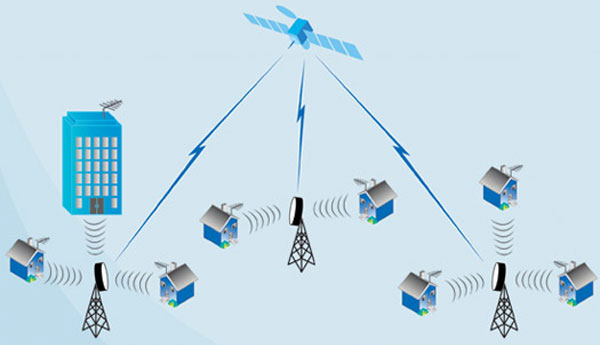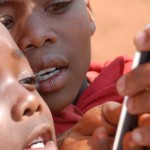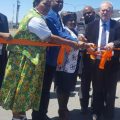South Africa’s move towards digital broadcasting, DTT, will bring more benefits for broadcasters, network operators, spectrum regulators and television viewers alike, says Deputy Director General in the Department of Communications, Ndivhuho Munzhelele.
“Our people need to understand that this digital migration revolution is going to change the look and feel of television in this country. Television studios are going to change for the better.
“The look and feel of television for the viewer is going to change dramatically because digital terrestrial television (DTT) brings with it better quality pictures… meaning the poorest of the poor will also enjoy better quality sound and pictures that are being enjoyed by those in the pay platform.
“There will also be opportunities for those who want to … become entrepreneurs, especially those who are aspiring to be in the TV production space such local film and drama producers, but are currently unable to find a platform to express or showcase what they are doing,” Munzhelele said.
DTT
Communications Minister Faith Muthambi is expected to announce the date for the migration of broadcasting services from analogue to digital soon.
The need for the DTT programme derives from the International Telecommunications Union (ITU) resolution, where countries in region 1 (including Europe, Russia, Africa, the Middle East and the Islamic Republic of Iran) should migrate their broadcasting services from analogue to digital by 17 June 2015.
The main reason for the migration is to release valuable spectrum, which can be used for other services. Spectrum is scarce and it is therefore necessary to make efficient use of the spectrum available for more telecommunications and broadcasting services.
To help in the migration process, government will provide free set top boxes (STBs) to more than five million poor household owners to migrate broadcasting services from analogue to digital.
Munzhelele said local entrepreneurs need to look at other opportunities presented by digital migration.
“While the manufacturing of STBs offers opportunities to create jobs and build excellence in electronic manufacturing, entrepreneurs need to look at opportunities that will come as a result of us switching off the analogue signal and when every household (which will have an integrated digital television set) will no longer require a set top box.
“Entrepreneurs have to be forward looking, partnering with the well-established electronics companies to be able to produce television sets at low cost, which will be affordable to our people in order to supply that market in the future,” he said.
Munzhelele said in the next 10 years, all 13 million television sets in the country must be changed.
“People need to understand that the opportunities are not necessarily in the STBs [alone]. What we need as a country are forward-looking people, who are going to be investing in the manufacturing of digital television sets.
“In the television sets, there are other downstream industries with benefits. There are people who will be supplying … certain components that must be in the television sets. The issue of design forms part of all those things…
“There are huge opportunities that open up doors for many people but it is unfortunate that people don’t talk about that. People talk about the issue of encrypting content without being really worried about content generators,” Munzhelele said.
Control system in STBs
In the Broadcasting Digital Migration (BDM) policy published in the Government Gazette on 18 March, it is explained that Cabinet’s decision to include a control system in STBs will not control how broadcasters manage their content.
Munzhelele told the Joint Portfolio Committee on Communications and Telecommunications and Postal Services on 10 March that the control system does not mean a conditional access system nor does it mean an encryption of the signal to control access to content by viewers.
“A control system refers to a security feature to encourage the local electronic manufacturing sector,” he said at the time.
He said in the event of theft, the set top boxes would be designed in a way that they do not work outside the country’s borders.
“The set top boxes must have minimal switching on or off security feature to protect the subsidized STBs from theft or leaving South African borders,” he said.
Conditional access, on the other hand, refers to the process of limiting the ability to view content, unless one pays for it.
The issue of whether to include the control system in the STBs has been a source disagreement amongst free-to-air broadcasters for some time now. This disagreement was the main reason South Africa was unable to implement DTT within the ITU-agreed timelines to switch from analogue to digital broadcasting signal.
Minister Muthambi has explained that government has increased tariffs on imported set top boxes and stipulated a local content quota for the subsidised set top boxes to support local manufacturing.
Earlier this month, the Minister said government has consulted amply on digital migration and the issue of STBs.
“Government has consulted all interested parties on the digital migration policy. One of my predecessors was even taken to court by eTV. The decision of that court has been respected in the policy.
“Encryption is a commercial decision to be made by individual broadcasters and they remain free to make this decision and manage it at their own cost,” said Minister Muthambi.
Referring to an article published in the Business Day entitled “Threat of close control over TV content”, the Minister said there were factual inaccuracies in the article.
“Firstly, the STBs will have a secure bootloader so it is factually incorrect to say that any malicious software can be downloaded,” she said.
She referred to South African National Standards (SANS) 862 of the South African Bureau of Standards (SABS), which is the standard for free-to-air STBs. It stipulates the requirement for a secure bootloader.
The Minister said paragraph 6.3.2.1 of SANS 862 deals with the secure download function.
“Encryption is required to switch off the services of a subscriber. It is not [necessarily] to protect content. If this was the case, why have other public broadcasters across the world not encrypted their digital terrestrial broadcasting signal? In fact, public broadcasters like the BBC specifically rejected encryption because they feared it could undermine universal access.
“Encryption does not prevent content from being pirated. Pay TV broadcasters spend a fortune fighting piracy. We know this because they continue to lobby for stronger measures to combat piracy,” she said.
Minister Muthambi said the SANS 862 specification, specifically paragraph 4.1, Table 1, indicates the major hardware and firmware requirements for the decoder, which makes High-bandwidth Digital Copy Protection (HDCP) mandatory.
“The existing policy allows for mass messaging,” the Minister said.
Also, Minister Muthambi said, government will require a security feature to protect its investment in the subsidised STBs to prevent subsidised STBs from functioning outside the borders of the republic.
Embracing digital migration
Munzhelele said government has to date invested R3 billion in the DTT project.
The investment also covers digitising Sentech and SABC infrastructure, including its studios and cameras.
He said government has also been able to incentivise existing broadcasters such as the SABC, eTV and M-Net by allocating enough spectrum in the existing multiplex for them to be able to carry more channels.
“As government, we were open-minded towards our broadcasters. We offered them incentives channels, where the SABC, eTV and M-Net will also get more channels that will also not be subjected to the licensing conditions of the Independent Communications Authority of South Africa (ICASA)…
“All they need to do is to apply for the authorisation of the channels from the ICASA.”
Munzhelele said the implementation of DTT requires a number of role players.
He said government’s job is to set the policy framework. Broadcasters must ensure that there is content available. Sentech has to ensure that the network is ready, while government has to ensure that five million poor households get STBs for free.
Local manufacturing of STBs, Munzhelele said, is an important part of the entire package.
“That is at the crux of what we are doing as government. The STBs will be primarily sourced from local manufacturers. Those who are given an opportunity to do must not stop at manufacturing an STB – we want them to graduate to be able to service the TV market.
“… We are giving them a start so that they are able to make the necessary investment to use the same factories to manufacture television sets in future.
“The STBs are just a starter… If you are in the space of manufacturing, think about the main course, which is integrated digital television sets, which will not require a STB,” he said.
Munzhelele appealed to South Africans to embrace digital migration the same way they embrace other technology.
“We have a very good story around the uptake of mobile [phones] in this country, where the mobile penetration is more than 100%.
“South Africans’ attitude towards technology is a positive one and we say the same attitude that they have towards mobile phones should now be carried towards the broadcasting space so they can enjoy better quality television in their own homes free of charge.
“Let’s have a positive attitude that the change which is coming is for the good for all of us,” he said. – SAnews.gov.za








